The Southwick Studio Then & Now

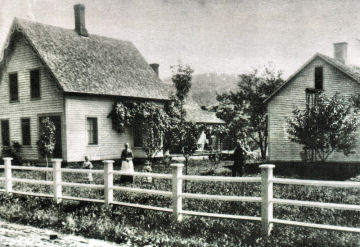
 A photograph from the early 1850's
A photograph from the early 1850's
of Joseph Ballard Taylor and his family
The Origins: Joseph Taylor Farm, 1850 - 1934
The "Southwick" property derived its name from blacksmith Henry Southwick who owned the property for just over five decades (1883-1932). Originally, as is the tradition in small town New England, the property was once known as the "Joseph Taylor" farm. In 1849, Joseph Ballard Taylor, a native of Buckland and carpenter by trade, purchased two parcels of land on opposing sides of Upper Street in Buckland Center for what was to become a farm and place for Taylor to set up his carpentry workshop.
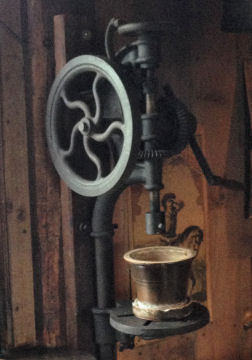
 A carpenter's drillpress remains
A carpenter's drillpress remains
in the studio to this day
The changing environment and economy, in early industrial New England, no longer supported farms
by their own volition. Farmers of the day, like Taylor, often subsidised their income with a trade like carpentry or blacksmithing to survive. On the parcel of land across the street
from what would become the Taylor's residence sat a pre-1830's blacksmith shop which he planned to convert into his carpentry workshop.
Taylor began building
the house and barn in 1849. It was completed in 1850. During that time, the blacksmith shop was picked up, moved across the street, placed just behind the house and converted
into Taylor's workshop. The house itself was built in the style referred to as Gothic Revival. Gothic Revival was not as popular a choice
as its cousin Greek Revival for that period in Western Massachusetts. However, there are four other known homes on Upper Street of the Gothic Revival style suggesting that Taylor,
through his trade, may have had a hand in their construction as well.
By 1870, the Taylors reportedly had 25 acres of land, they valued at $1,500. The farm consisted of
a horse, two milking cows, three other cattle, two sheep, a pig, and produced 50 bushels of potatoes, 8 tons of hay and made 100lbs of butter. Unfortunately, Joseph Taylor died the
following year and his wife Jane the year after (1872) leaving their son, only 14 at the time, the assets and property.
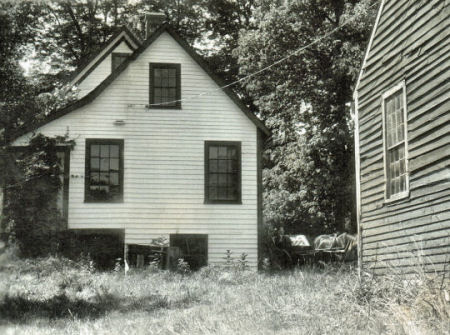
 A photograph of the back of the home with the blacksmith
A photograph of the back of the home with the blacksmith
shop to the
right before renovations. Woodward can be seen in
his buggy between the house and blacksmith shop. The
chicken coop attached to the barn will be moved to the back
of the house and the shop will be raised up 4 to 5 feet, in
order to provide Woodward access, via a ramp, to both
structures creating a wonderful breezeway and porch seen
in the image to the lower right. Woodward had a special talent of
marrying beautful aesthetics with utilty and functional practicality.
In 1874, the boy's guardianship petitioned the courts to sell the property in order to provide better care
for the boy, now 16 years of age. The house and land were put up for sale at auction and was sold for a reported $1,600. After nearly 25 years, the Taylors no longer are part of the
farmstead they began.
After two brief and unremarkable owners... a blacksmith from nearby Charlemont, Henry Southwick, purchased the farm and land in 1883.
Henry, the Southwick Studio's namesake, brought with him his wife Ida and 4 children to raise, restored the blacksmith shop to its original use and tended the farm land for the next
51 years. Ida passed away in 1924, two of the three children moved away, one child died young and the youngest, Ben, stayed for some time.. probably aiding his father in the blacksmith
shop before becoming a chemical salesman in White Plains, NY with a family of his own. Henry Southwick continued operating the blacksmith shop shoeing horse and oxen while
working the fields as late as 1930 before he passed in 1931. As a result, the property went to his son, now in White Plains. It sat idle for nearly 3 years, slowly deteriorating when Woodward
purchased it in August of 1934 for an undisclosed amount. Woodward would not initially be able to live on the property for the layout and landscaping were not suited to his particular needs.
A restoration would be necessary. One in which Woodward not only oversaw and supervised but designed many of the changes made to the property and buidings.
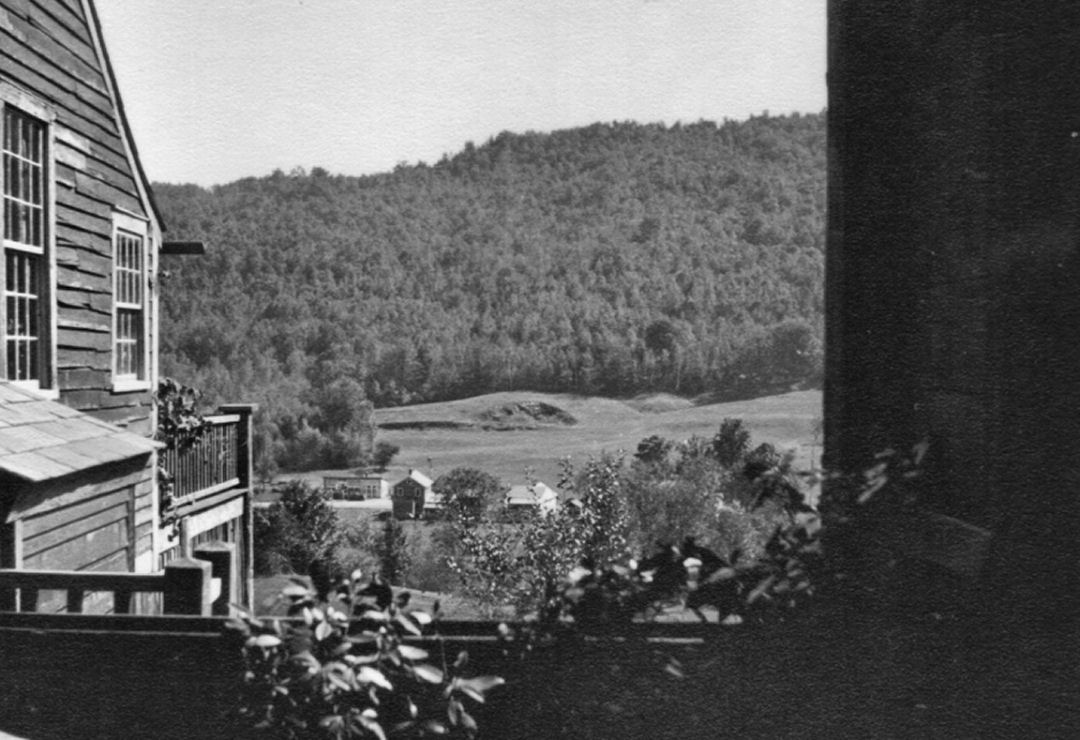
 A photograph view of the valley and hills behind
A photograph view of the valley and hills behind
the house from a porch behind the main house.
The Blacksmith Shop to Artist Studio & Residence
In 1934, Woodward lost his second studio to fire within 12 years, only this time the home itself was also
damaged. The only thing left standing of the Hiram Woodward Place was the barn. Woodward needed a new home and studio, despite still owning "The Little Shop" just down the road,
it was unsuited and too small to be made into a residence. Woodward's purchase of the "Joseph Taylor Farm" from Henry Southwick's son Ben in 1934 and it would become his last and enduring
home and studio until his death in 1957.
However, for Southwick to be a feasible residence and functional studio for Woodward's physical handicap work needed to be done
to level the property built on a sloping hillside making it fit Also, the rolling vistas to the south were blocked by the location of the barn located to the south of the house. Covered in great
detail in our Scrapbook page devoted to the reconstruction, we will be brief here and simply list the main changes:
------------------------------------------------------------------------------------------------------------------------------------------------------------
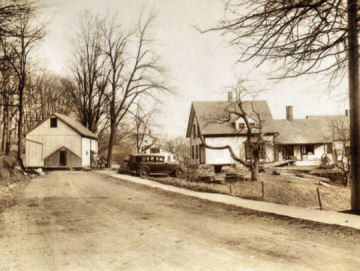
 A photograph of the barn in the road being moved
A photograph of the barn in the road being moved
by a pair of
oxen! It was moved by Woodward because
it was blocking the view of the southern valley, as well
as, much of its warm light for the cold winter months.
Note
that you can see the outline of the chicken coop!
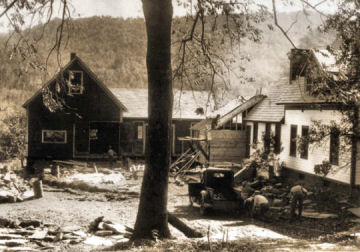
 A photograph of the the reconstruction looking
A photograph of the the reconstruction looking
east across the driveway.
The chicken coop is being
added to the back of the house and the now raised
blacksmith shop is being seamlessly attached to the
1900s carriage house. Note that
the extension
to the carriage house is not yet been added.
 the barn was picked up and moved to the northside of the home
the barn was picked up and moved to the northside of the home
 the chicken coop was also moved to be attached to the back of the house aiding the construction of a ramped walkway
to the coop and entry of the studio.
the chicken coop was also moved to be attached to the back of the house aiding the construction of a ramped walkway
to the coop and entry of the studio.
 the blacksmith shop was raised 4 to 5 feet to a position near a level to the rear of the house and attached chicken coop.
the blacksmith shop was raised 4 to 5 feet to a position near a level to the rear of the house and attached chicken coop.
 needing a first-floor bedroom, one was added to the south side of the house to serve as Woodward's bedroom.
needing a first-floor bedroom, one was added to the south side of the house to serve as Woodward's bedroom.
------------------------------------------------------------------------------------------------------------------------------------------------------------
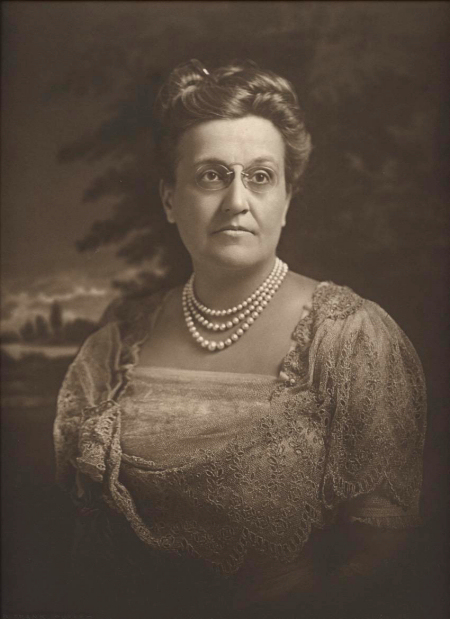
 Mrs. Ada Small Moore, renown art
Mrs. Ada Small Moore, renown art
collector
and philanthropist. Her col-
lection of Middle Eastern and Asian art
now resides in the collections of the
Yale University Art Museum system.
Aside from the insurance money Woodward received from the loss of the Hiram Woodward Place
much of the renovation funding was provided by the patronage of Mrs Ada Moore, wife of Henry Moore - industrialist and financier. Moore
was introduced to Woodward in his early years exhibiting in Boston through another patron and benefactor, Boston socalite, Mary "Minnie" Eliot. The Eliots and Moores were
part-time residents, neighbors, and friends in the northern Boston enclave of Pride's Crossing, MA.
Eliot is perhaps Woodward's most ardent advocate. Introduced
to Woodward through her cousin and Woodward's former classmate at the Bradley Polytechnic Institute in Peoria, IL, artist Joseph Cowell.
She twice played a critical role in raising the money he needed (1) to leave Los Angeles, CA in 1906 to attend the Museum of Fine Arts School of Boston; and again (2) in
1925, as part of a fundraising campaign to lift Woodward out of the financial distress that resulted from his 1922 Redgate studio fire.
The time period in and around the 1925 fundraising campaign is when we believe Mrs. Moore entered his life, first by establishing a trust to cover all the cost of his expensive
medical care for the remander of his life and secondly aid and assist his ability to travel and paint from open fields by purchasing a number of touring cars for him to work from,
most notably his 1936 Packard Pheaton as well as, a 1929 Nash Touring car. Woodward and Moore established a lovely friendship through
their shared interest in Asian artwork. We believe that the fact that Moore's brother was confined to a wheelchair for some undisclosed ailment, as well as, her husband's long
history with various illnesses furthered their bond and probably contributed to Moore's willingness to take on such a cause as Woodward.
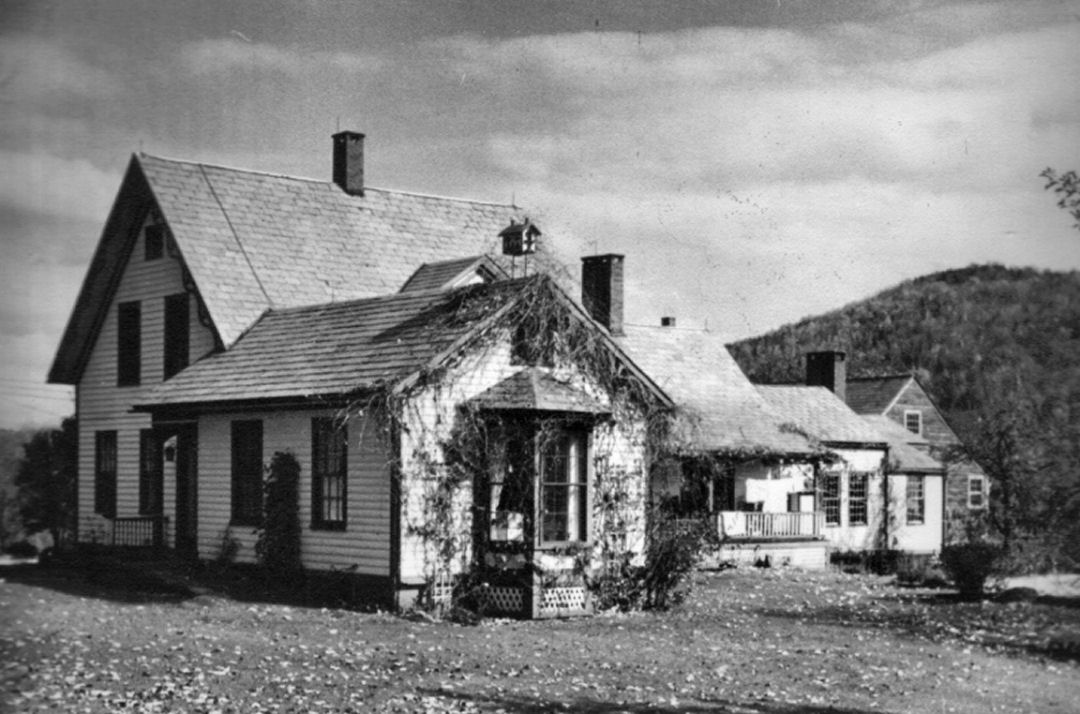
 A photograph of first floor bedroom added after Woodward purchased
A photograph of first floor bedroom added after Woodward purchased
the property.
Note from this perspective the conjoining buildings lined up
in what appears to be a zig-zag plan. This zig-zag composition appears
in many of his paintings as a perspective for which he
had a special
appreciation for a New England tradtion.
Besides moving buildings around for a more pleasing aesthetic and flow, Woodward also added a number of additions to various buildings. First and foremost, he needed a first floor bedroom and bath due to his physical limitations. In true Woodward fashion, he designed an annex to be seamlessly attached to the southside of the original house. He was very careful to design it in such a way that it (1) looked as if it had always been part of the house; (2) that it would be in the same gothic revival style which features a south-facing bay window matching the original home's south facing bay window, as well as, an east-facing large picture window for light and the view of the valley; (3) a louvered gable trimmed with matching vergeboard treatments running along the entire roof line; and (4) using the new structure to absorbed and serve functionally to add a stone ramp he could use to exit his front door. Below is an image of Woodward's draft of his vision for the new annex, including the bay window and stone-laiden chair ramp.
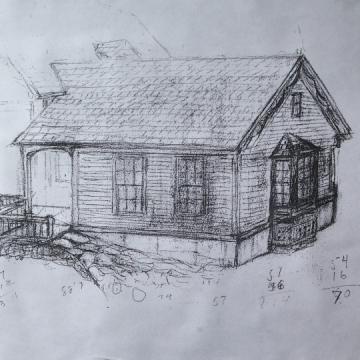
 Hand drawn draft of RSW's design for the addition
Hand drawn draft of RSW's design for the addition
As we have already mentioned, the chicken coop once attached to the barn was added to the rear of the house to fashion a ramp from the house to his studio. Beside raising the studio the four to five feet to a level closer to the elevation of the house. He also added an extension to the northside of the old blacksmith shop in order to attach it to the existing carriage house. That extension included the installation of his famed north window and for just one more great view added a balcony to the rear of the new studio. Again, this was done skillfully in such a way that it appears to have aways been that way. More about this is covered in Part Two of this story about the Southwick Place featuring just the studio itself.
The carriage house was also added too. An extension was added to the left (facing front) in order to add storage and a work area for his handimen. This also closed the distance between the carriage house and the barn creating another wonderful breezeway taking you to the backyard where he had a garden and large patch of rhubarb growing just under his north
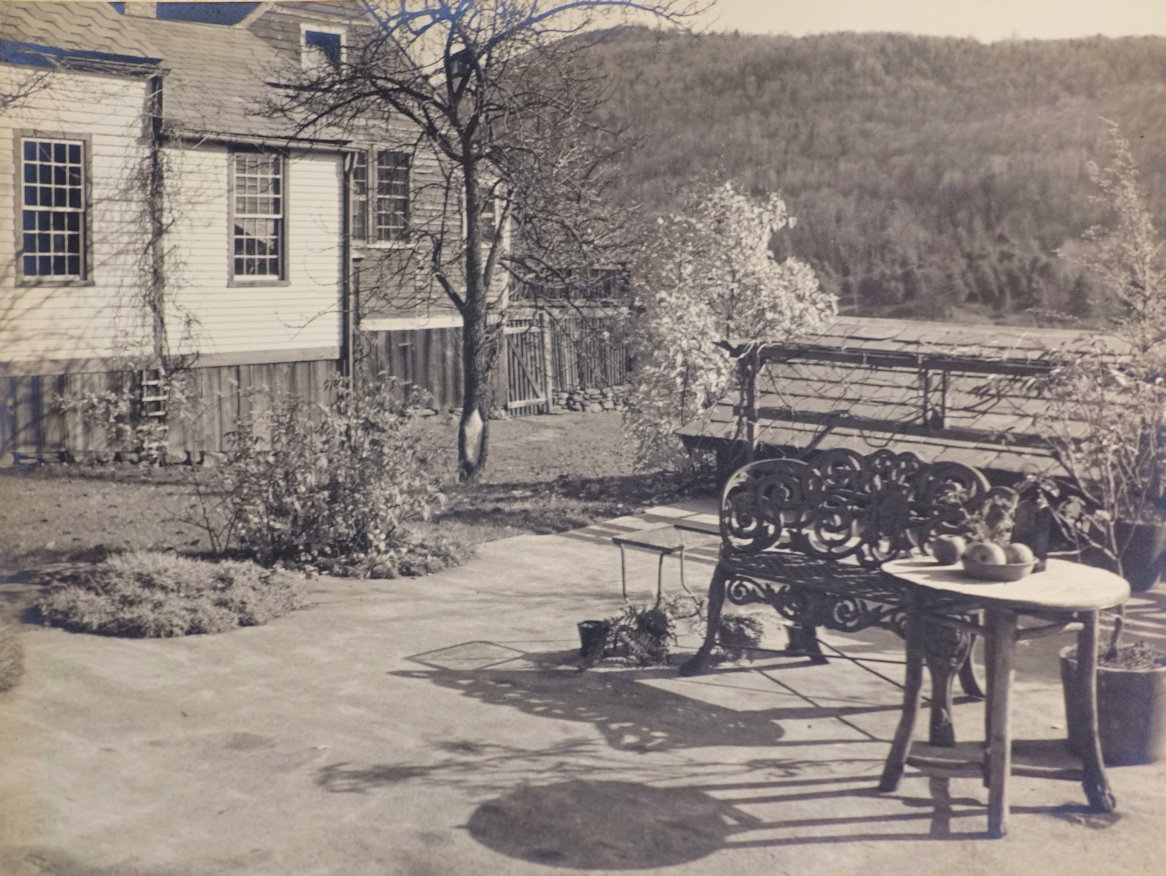
 Southwick's Tea Terrace. The wrought iron
Southwick's Tea Terrace. The wrought iron
railings, bench and table
stands all remain. The
table tops are reporposed former grinding stones.
This image also shows the southern exposure of
the house and note the balcony on the studio.
window. Not only that, the extension gives a clean sightline to add a retaining wall of field stones, many of them salvaged from his previous home & studio, and extending the driveway to the newly placed barn. Finally the barn was lengthened for more space and an addtion was added to the northside rear of the barn to create a stable sancturay for his horses to retreat from the sun or inclimate weather. See the images below for more...
The space left behind by the barn was converted to a terrace Woodward called the tea terrace. Tea terraces were a traditon of sorts for him. The Hiram home had one and his heath getaway, the Pasture Studio did as well. In fact, we believe that the color scheme of a white home with green trim, a red studio, and a soft green barn with white trim was the same configuration of the Hiram Woodward Place. More on the tea terrace Woodward added... using the foundation from which the barn rested, Woodward had a concrete slab laid on top. Under the slab he had a sleigh shed built (now called the pool house). This shed stored his winter sleighs and a multitude of other things. It was plummed, and on the south side features a rose trellis, with an area designated for potting plants and flowers, as well as, gardening and landscaping tools.
------------------------------------------------------------------------------------------------------------------------------------------------------------
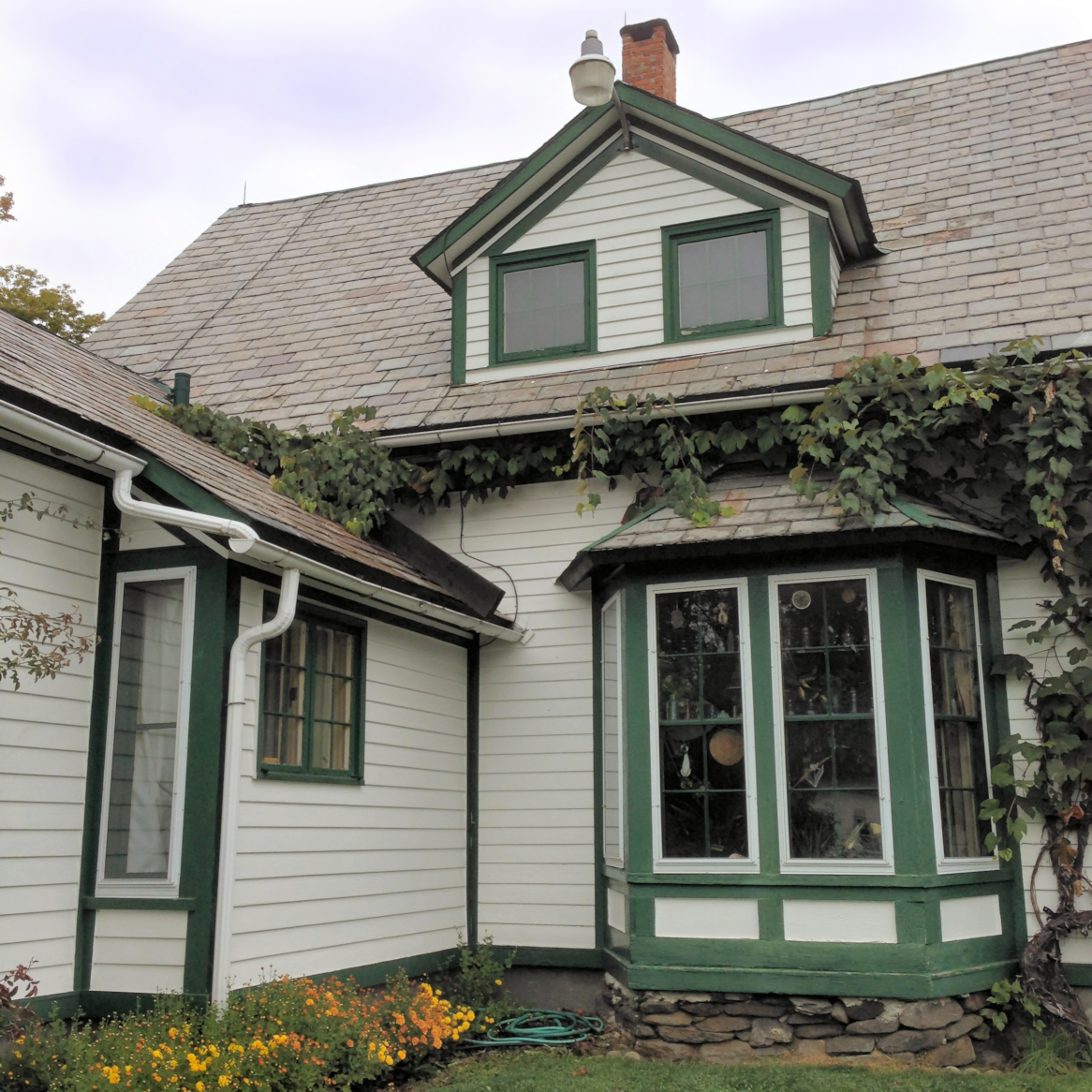
 The original gothic bay window today
The original gothic bay window today
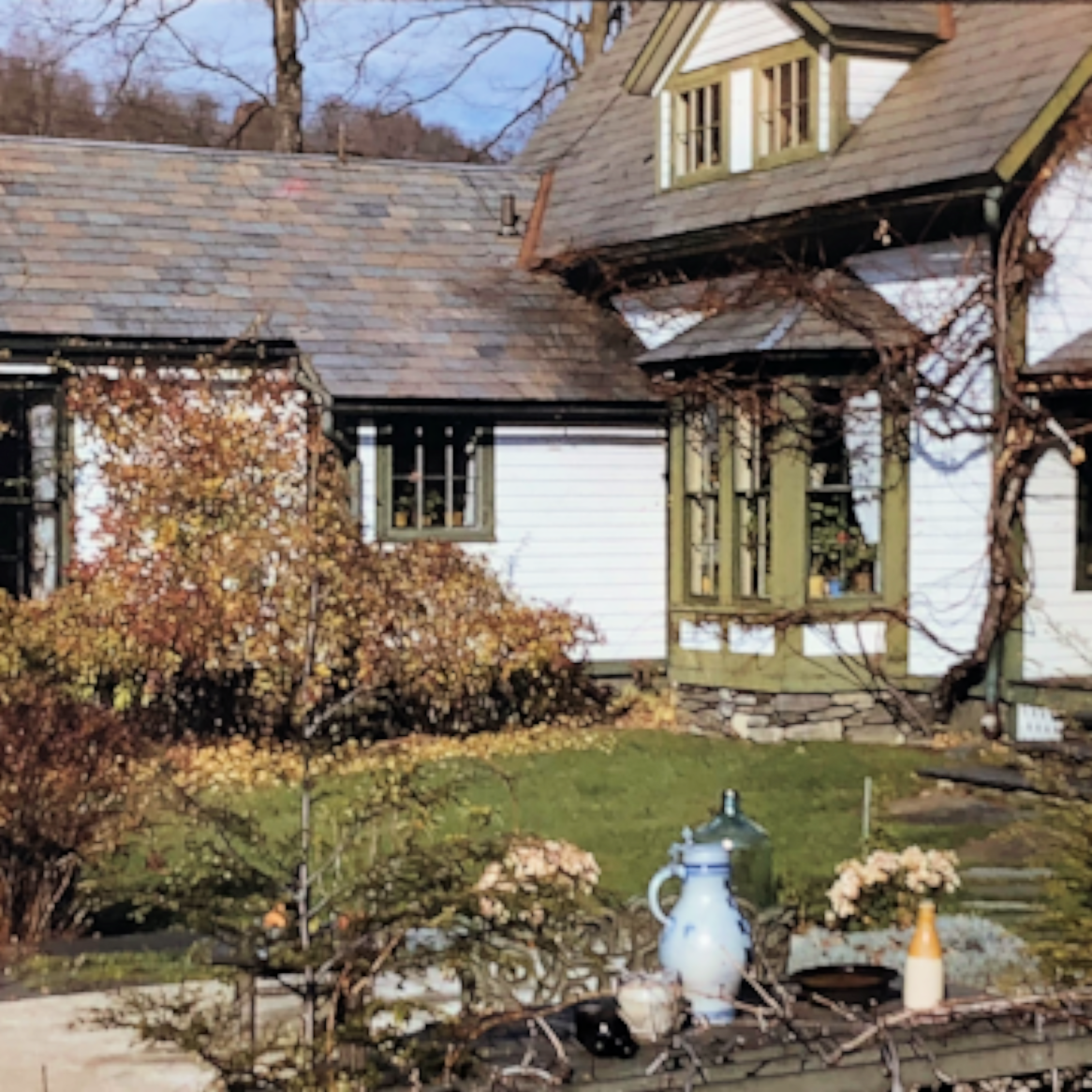
 The original gothic bay window late 1930's
The original gothic bay window late 1930's
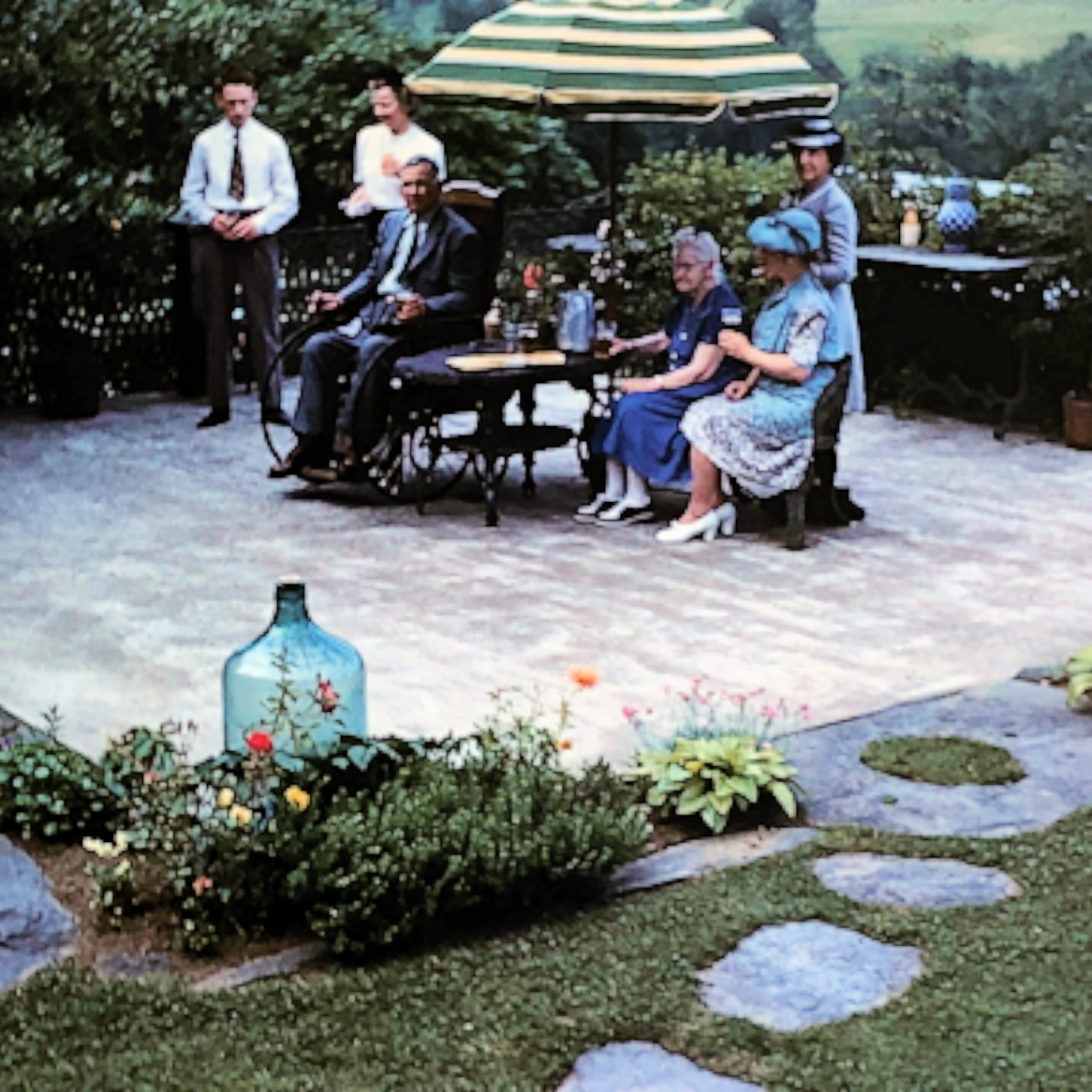
 Woodward, to his right, his mother
Woodward, to his right, his mother
Mary and Mark standing to his left
entertain guest on the tea terrace
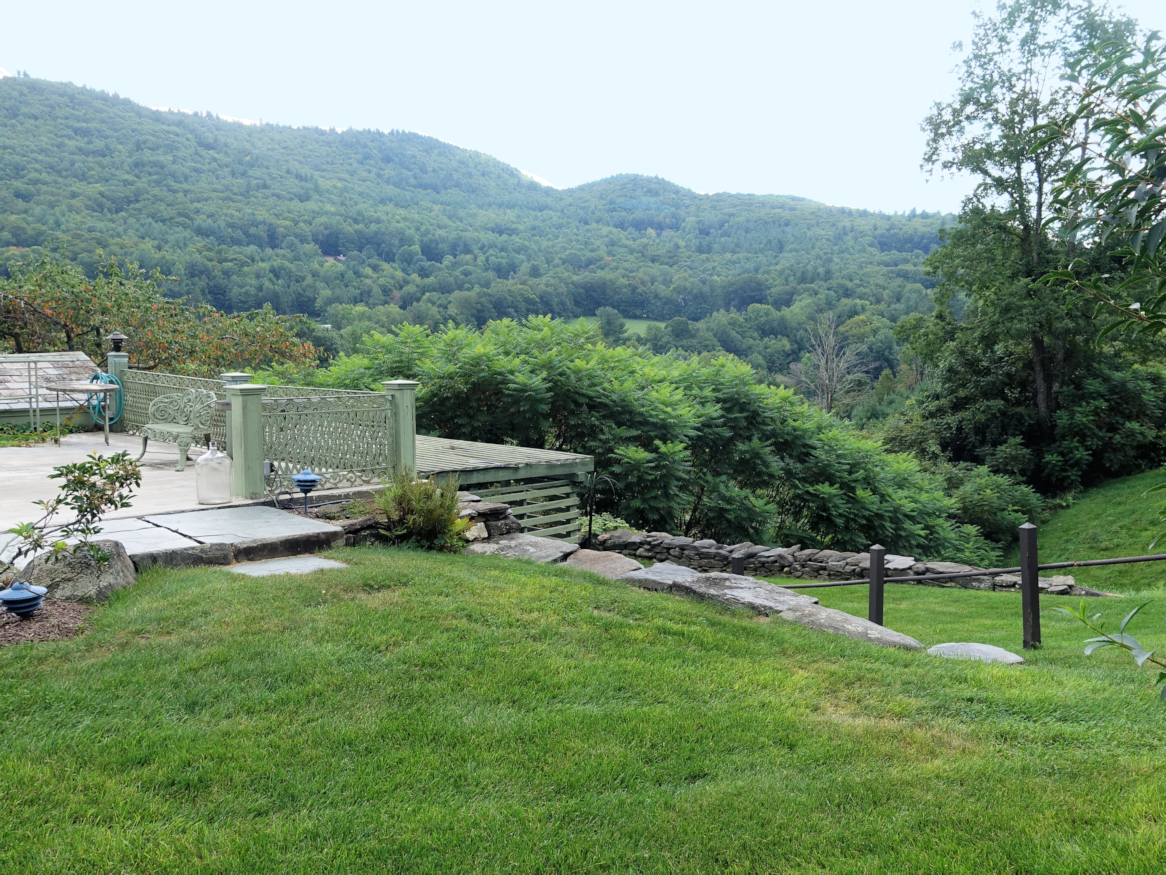
 The tea terrace with the rose trellis in view
The tea terrace with the rose trellis in view
looking southeast down the valley. The stone
wall just beyond the trellis leads to the lower
terrace where Woodward liked to picnic.
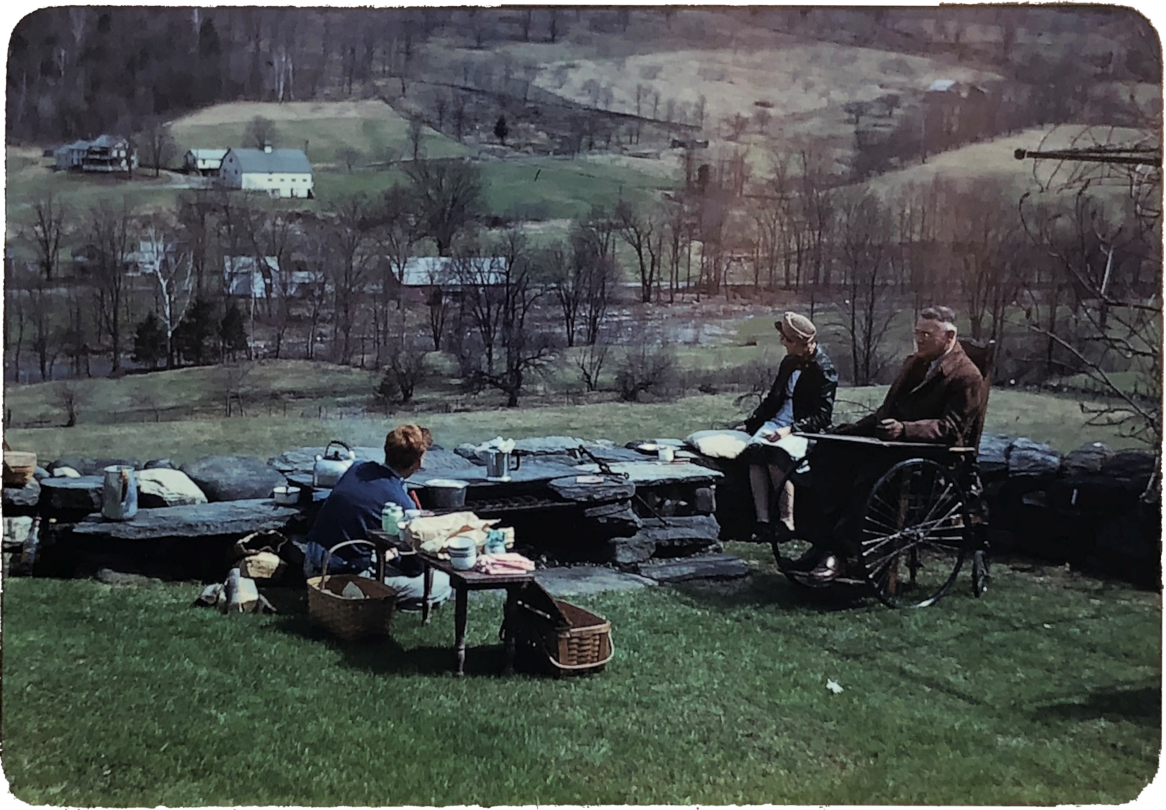
 Woodward, Mark and a friend picnicing on the
Woodward, Mark and a friend picnicing on the
lower terrace overlooking the valley. Note the
stone arrangements, Woodward liked to fashion
field stones he selected into cooking stones.
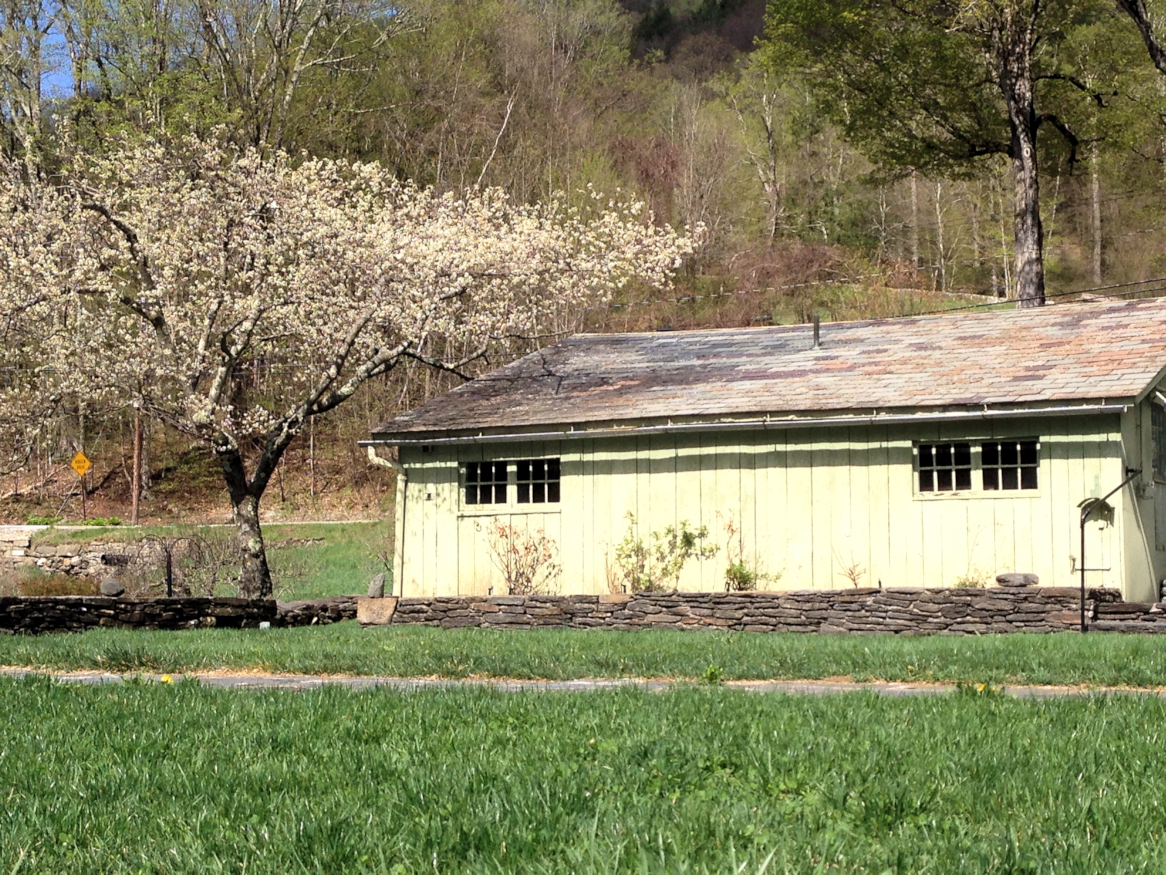
 Here we see the sleigh shed. Above it is the
Here we see the sleigh shed. Above it is the
tea terrace and just to the left of that tree
is the lower picnicing terrace. In Woodward's
day, this is where the landscape design ends
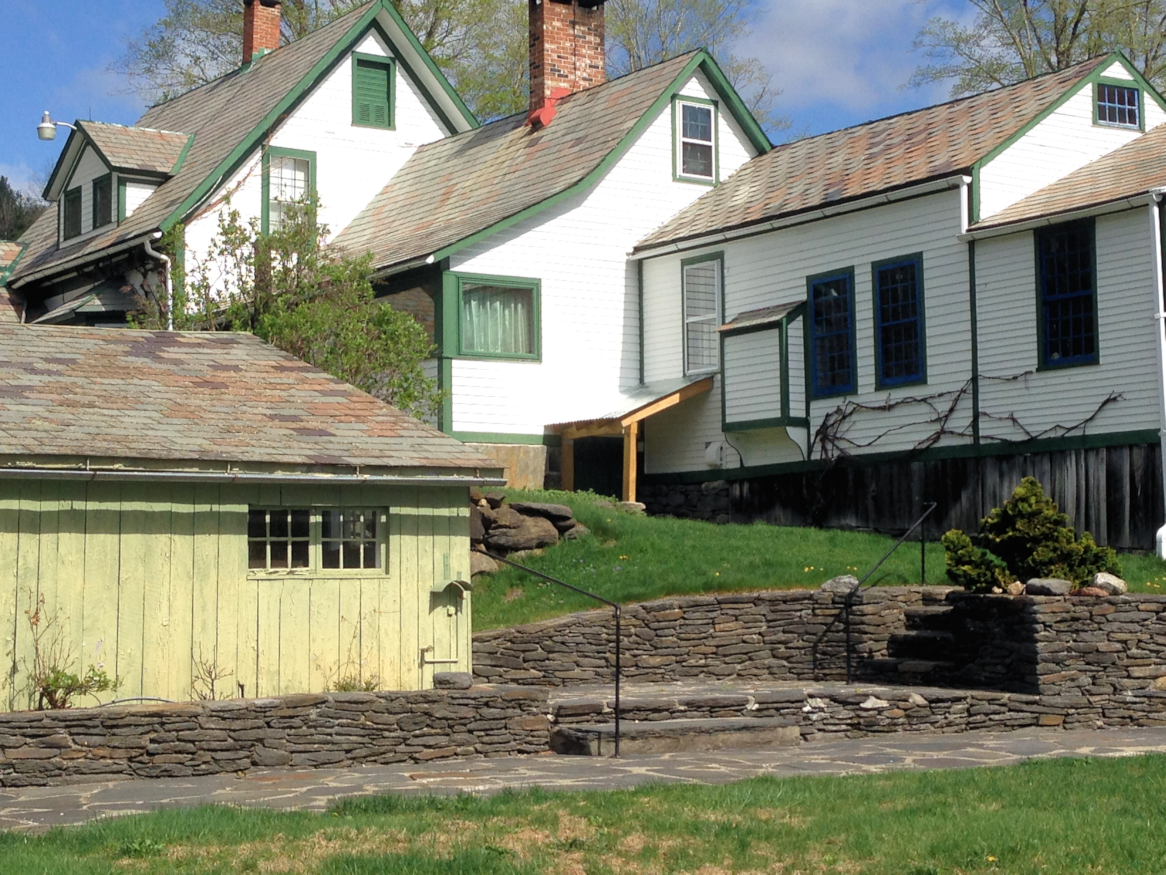
 The sleigh shed was converted into a pool
The sleigh shed was converted into a pool
house by Dr. Mark. Behind it is the gardening
shed. The stonework you see was added by Dr.
Mark to install a pool which is today filled.
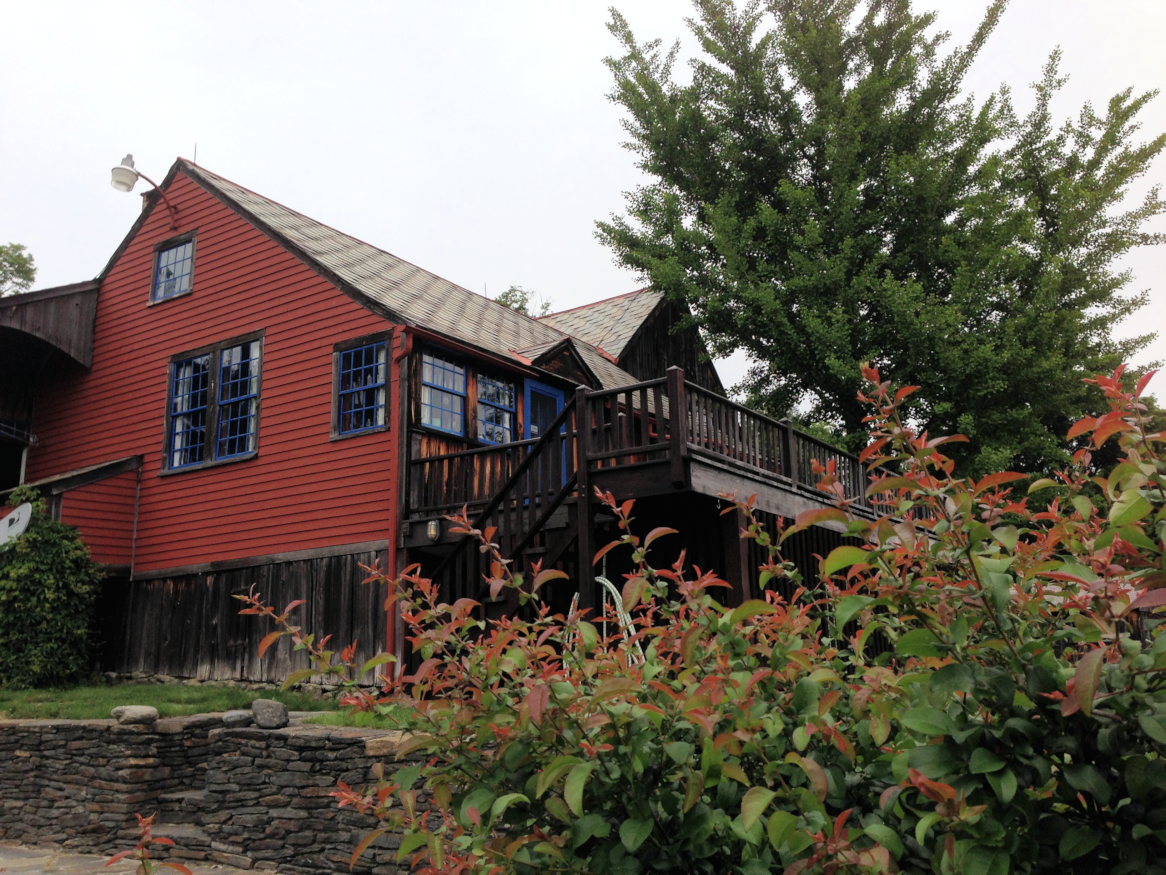
 Shifting to the right this photo, taken from
Shifting to the right this photo, taken from
the same spot as the previous image, shows the
southeast corner of the studio with the added
balcony featured in Sun on the Balcony
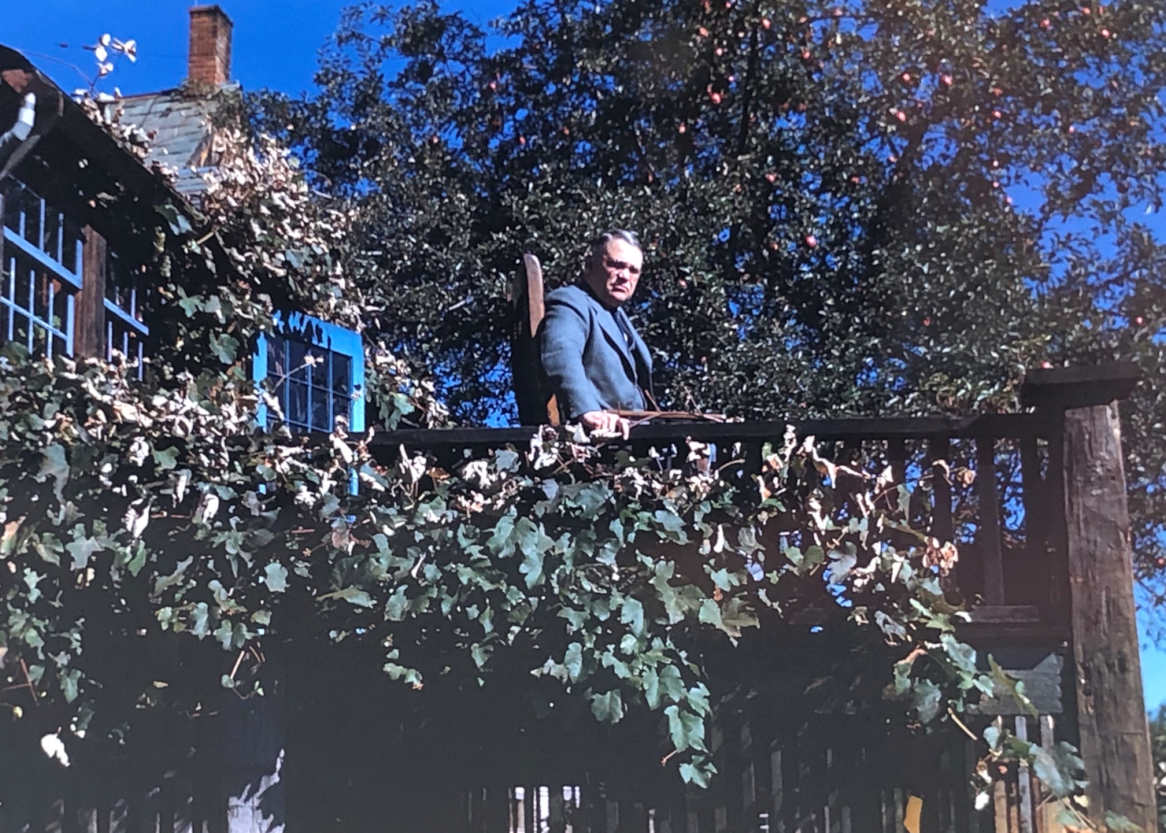
 Woodward sitting on his studio balcony
Woodward sitting on his studio balcony
around the late 1930s. One of only a handful of
color pictures we have of him. Woodward loved
nature. He wanted to be surrounded by it in
every way so you will see a lot vines growing.
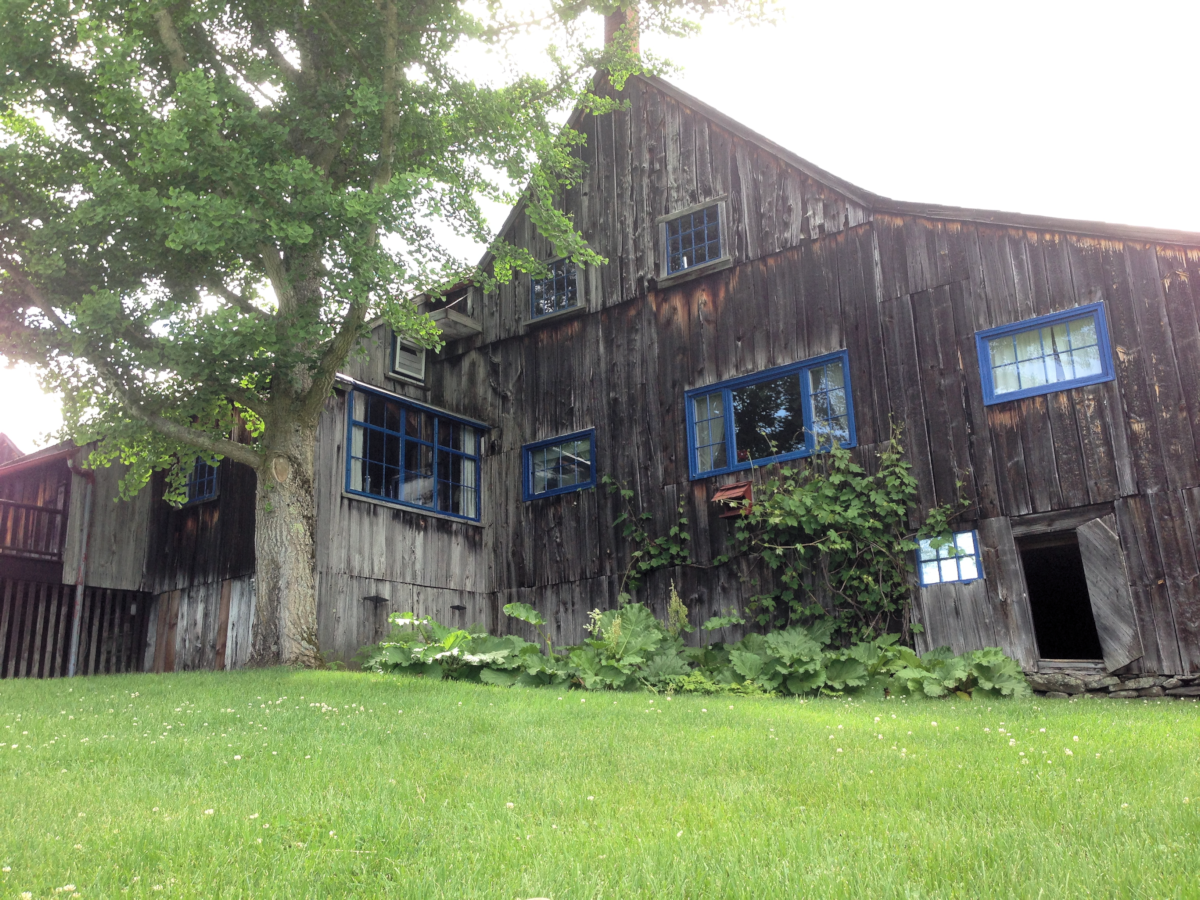
 Moving to the back yard behind the studio
Moving to the back yard behind the studio
and carriage house you can see the north window.
Note the difference in the age of the wood
around it. The window was added and the studio
extended to connect with the carriage house.
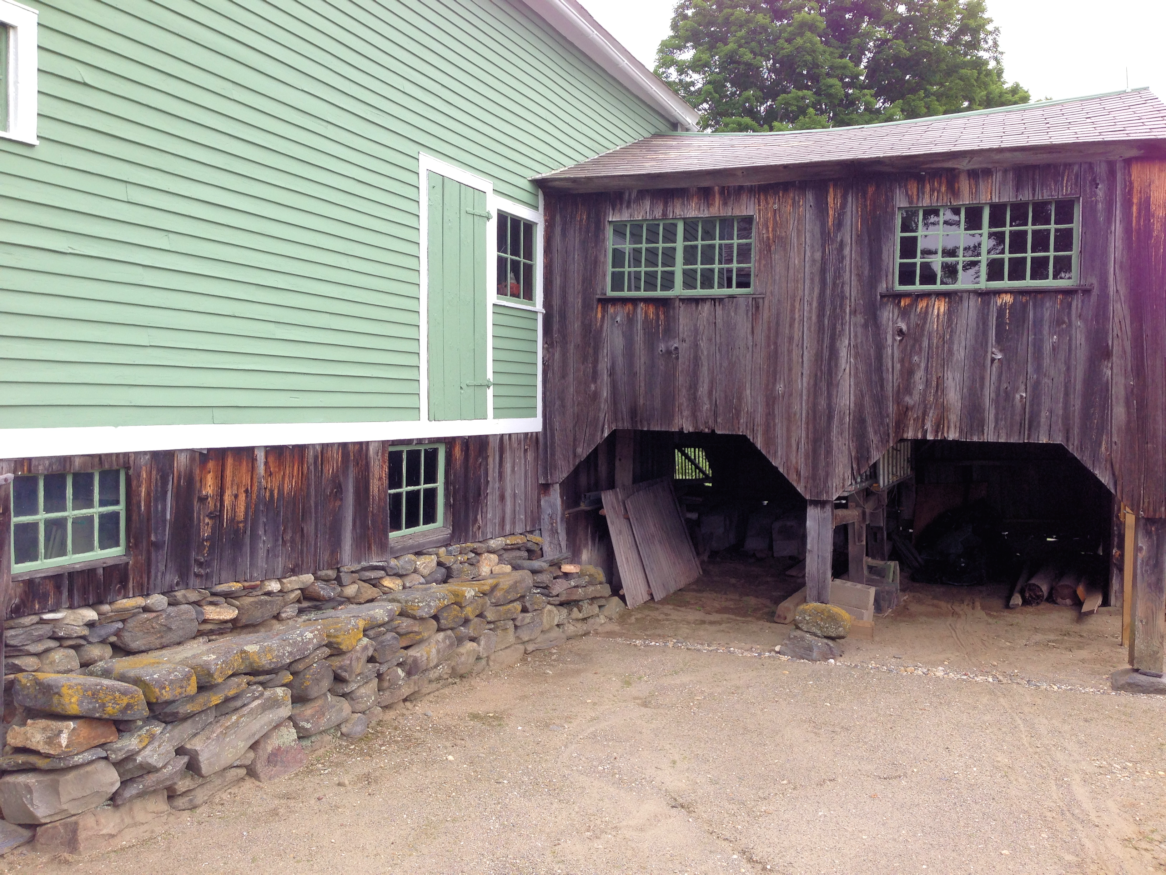
 The stable area of the rear barn showing the
The stable area of the rear barn showing the
extention for a horse shelter. Above it a room was
built for additional storage. The door you see
that goes to nowhere is original to the barn from
when it was on the south side of the house.
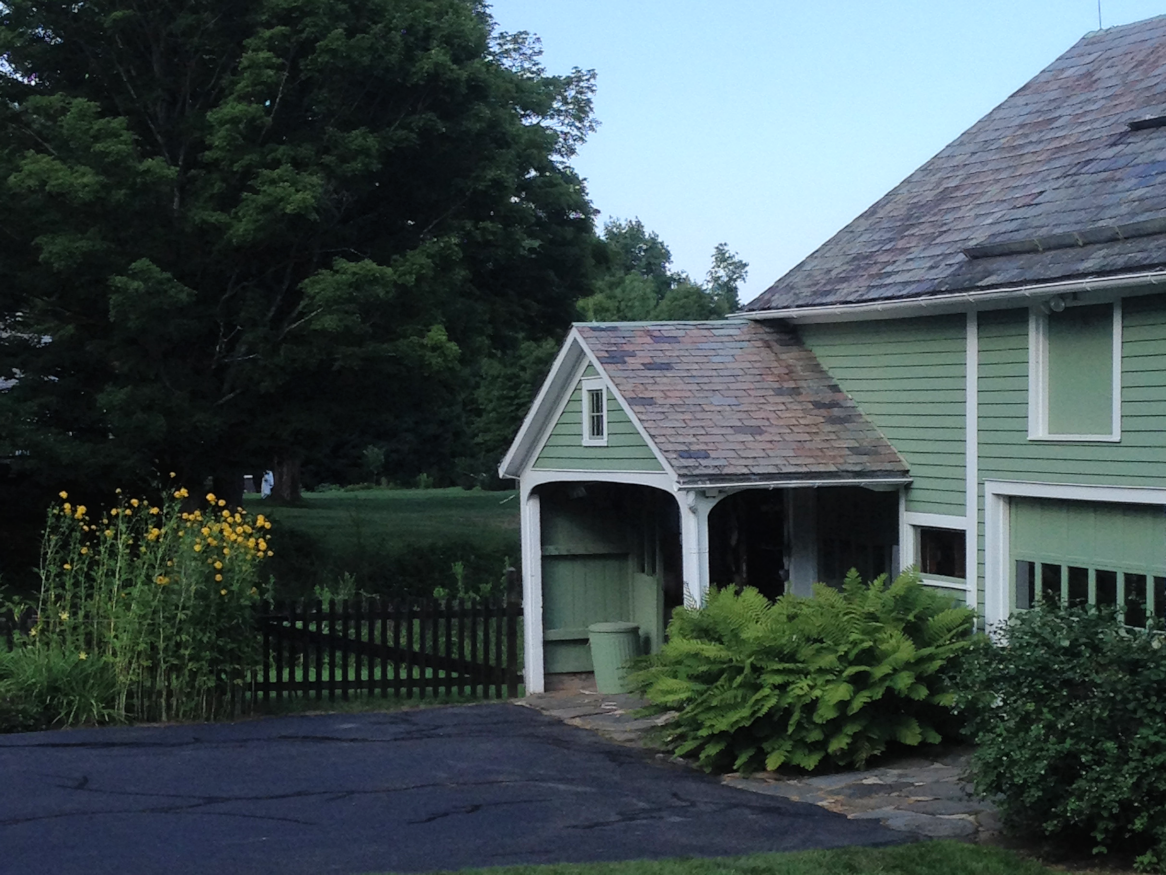
 The northside front of the barn shows an
The northside front of the barn shows an
overhang was added to the exterior but what is
more difficult to see is that the barn was
lengthened several feet, we believe, beginning
with the first post of the overhang. All changes
to original buildings had to be seemless.
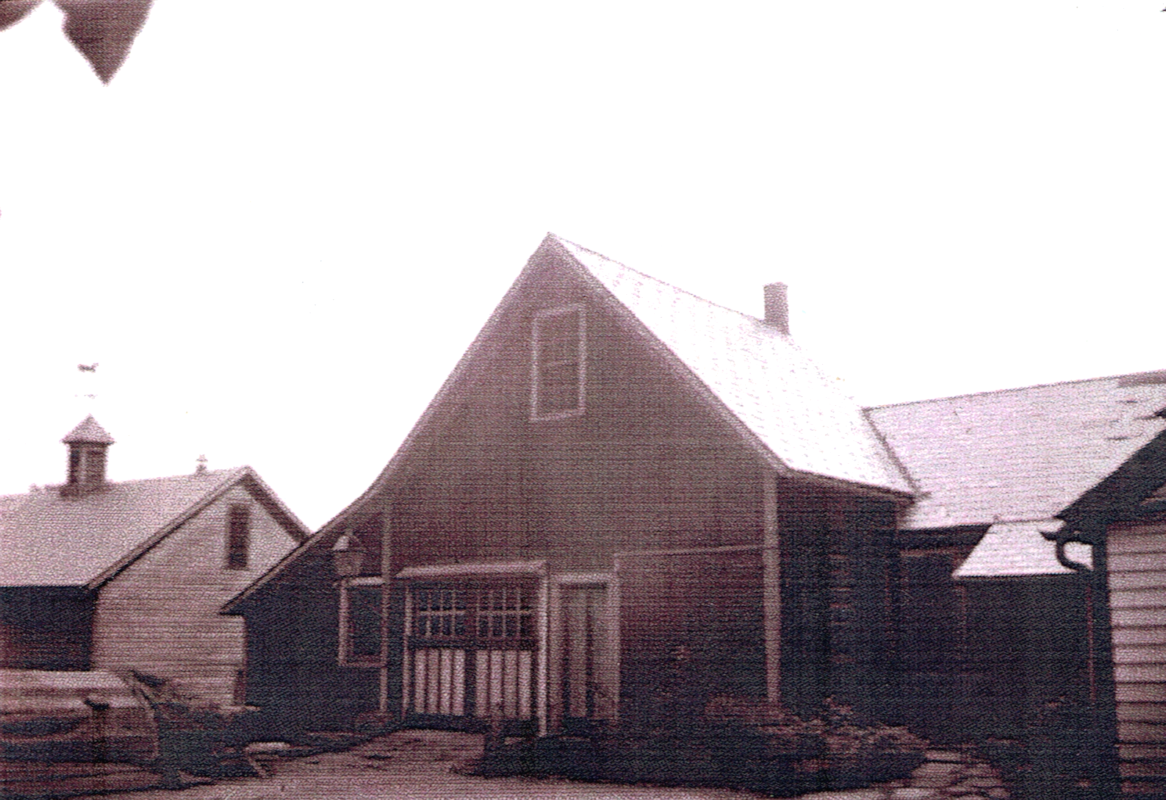
 An old, grainy picture of the carriage
An old, grainy picture of the carriage
house with the addition before the retaining wall
was built to form the driveway. Note how, once
again, Woodward's design seemlessly blends
the studio to the building next to it.
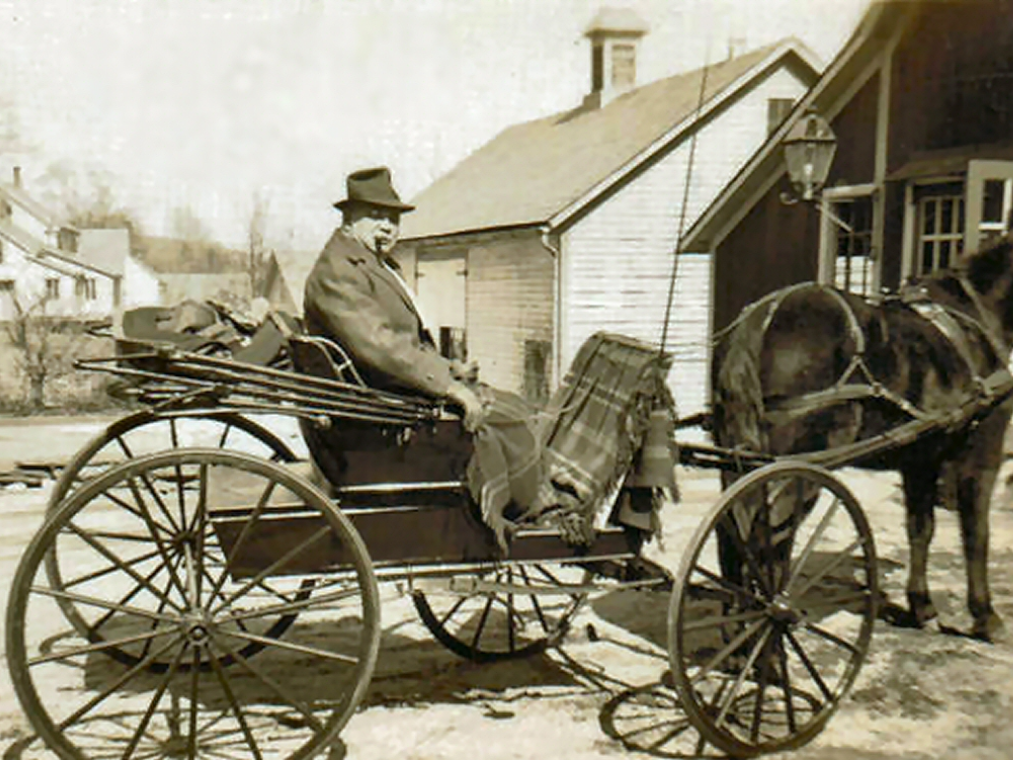
 Woodward in his horse-drawn buggy
Woodward in his horse-drawn buggy
overseeing the work being done. Though a
landscapist by trade, his father was a success-
ful real estate developer. He knew his way
around a construction project.
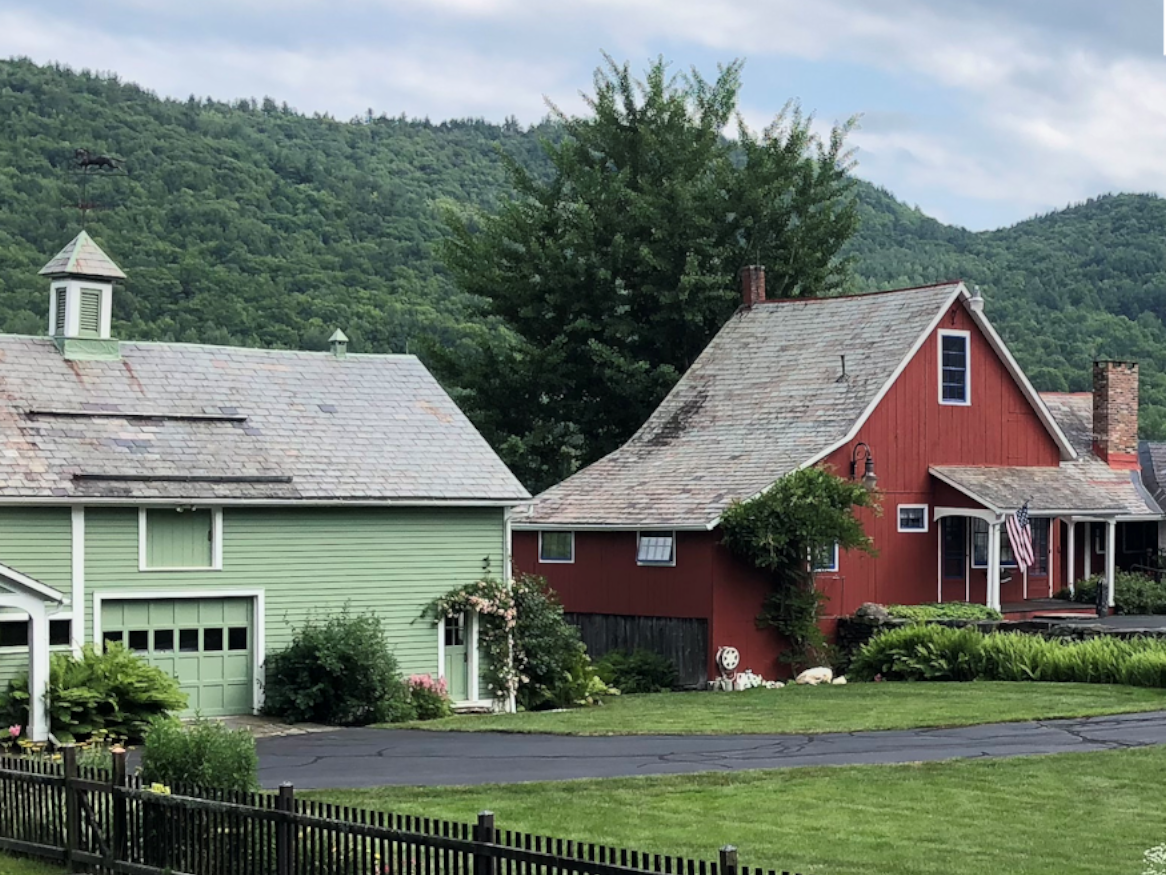
 The carriage house and barn today.
The carriage house and barn today.
Woodward had always aspired to leave his
beloved Mark a place for him to set up shop.
When Mark planned to be a pianist, Woodward
had the Little Shop to leave him but for a
doctor with a family, he left him Southwick.
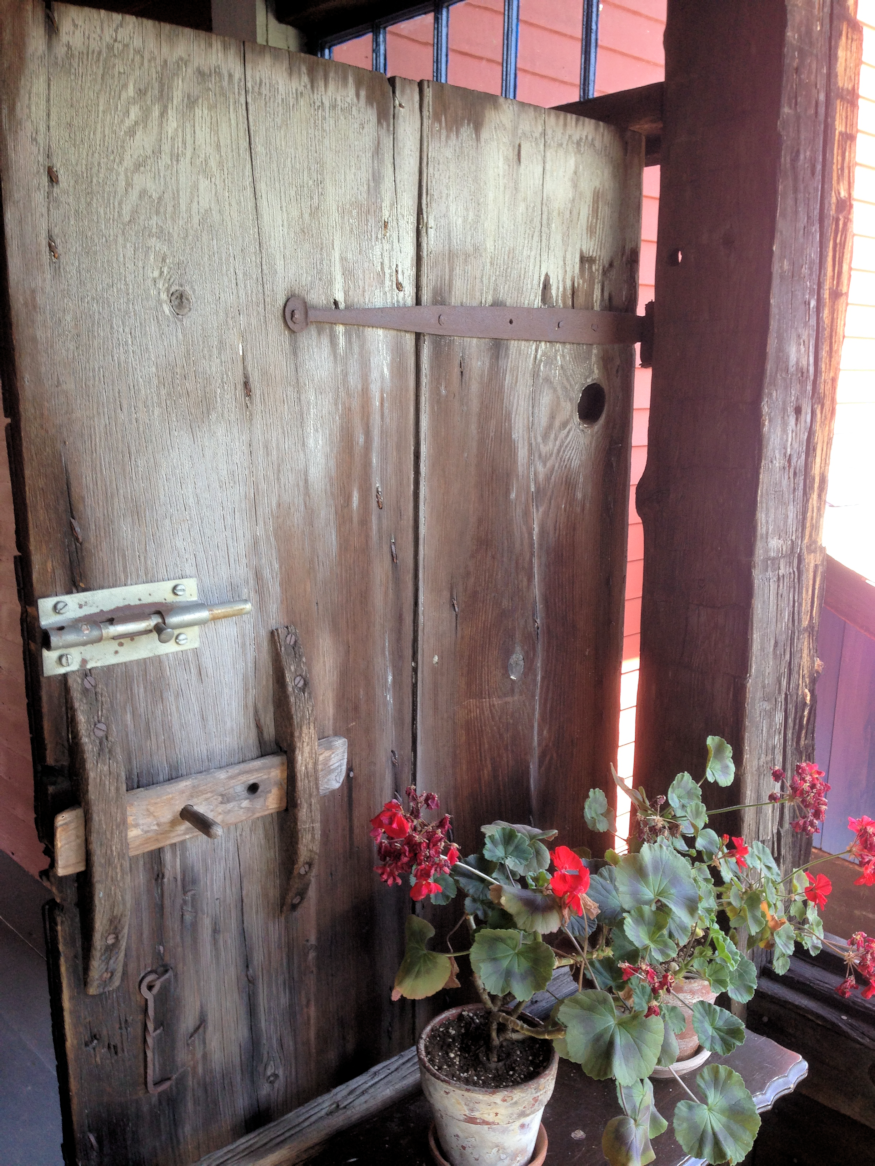
 The gate from the breezway between the
The gate from the breezway between the
house and studio. There is a small sitting area
to view the hills to the east. The gate leads
down some stairs toward the sleigh shed.
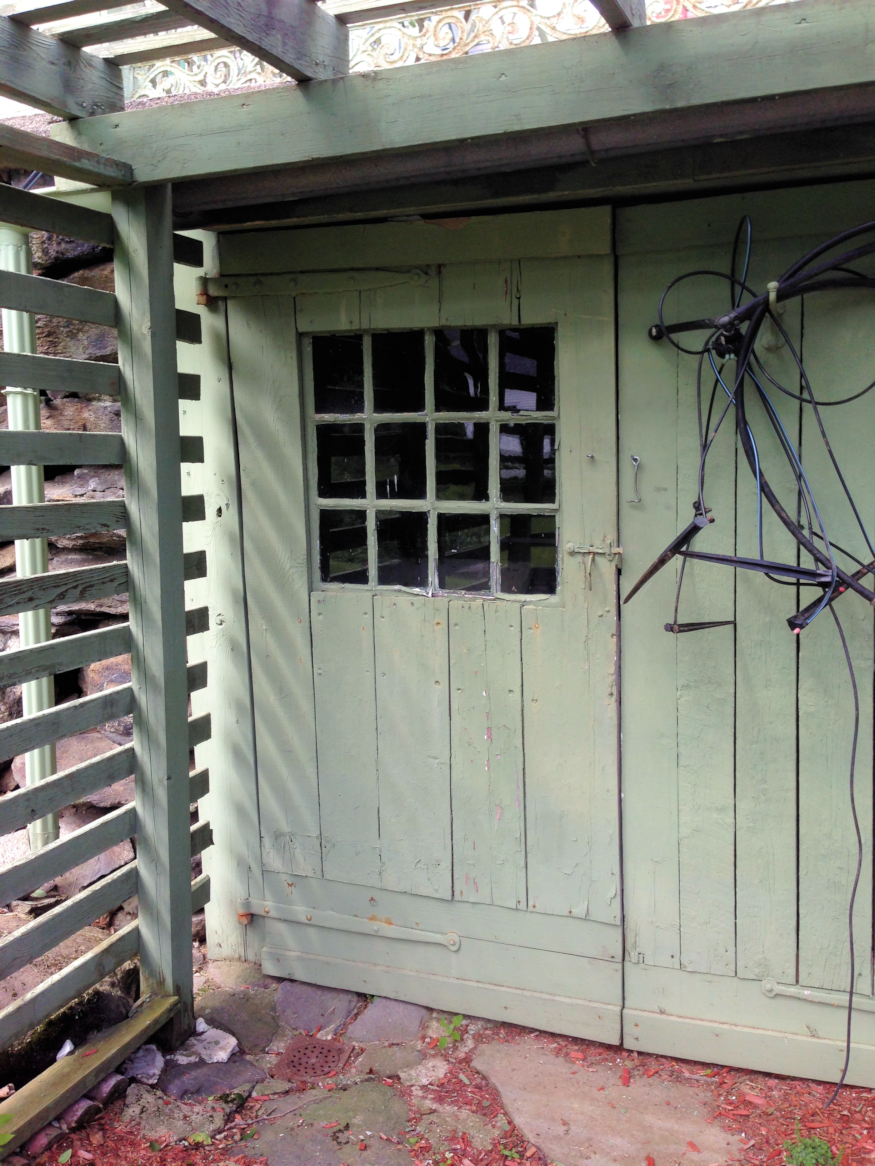
 The door to the garden shed under the
The door to the garden shed under the
tea terrace. Inside the shed one can see
the old foundation to the original location
of the barn and now supports the terrace.
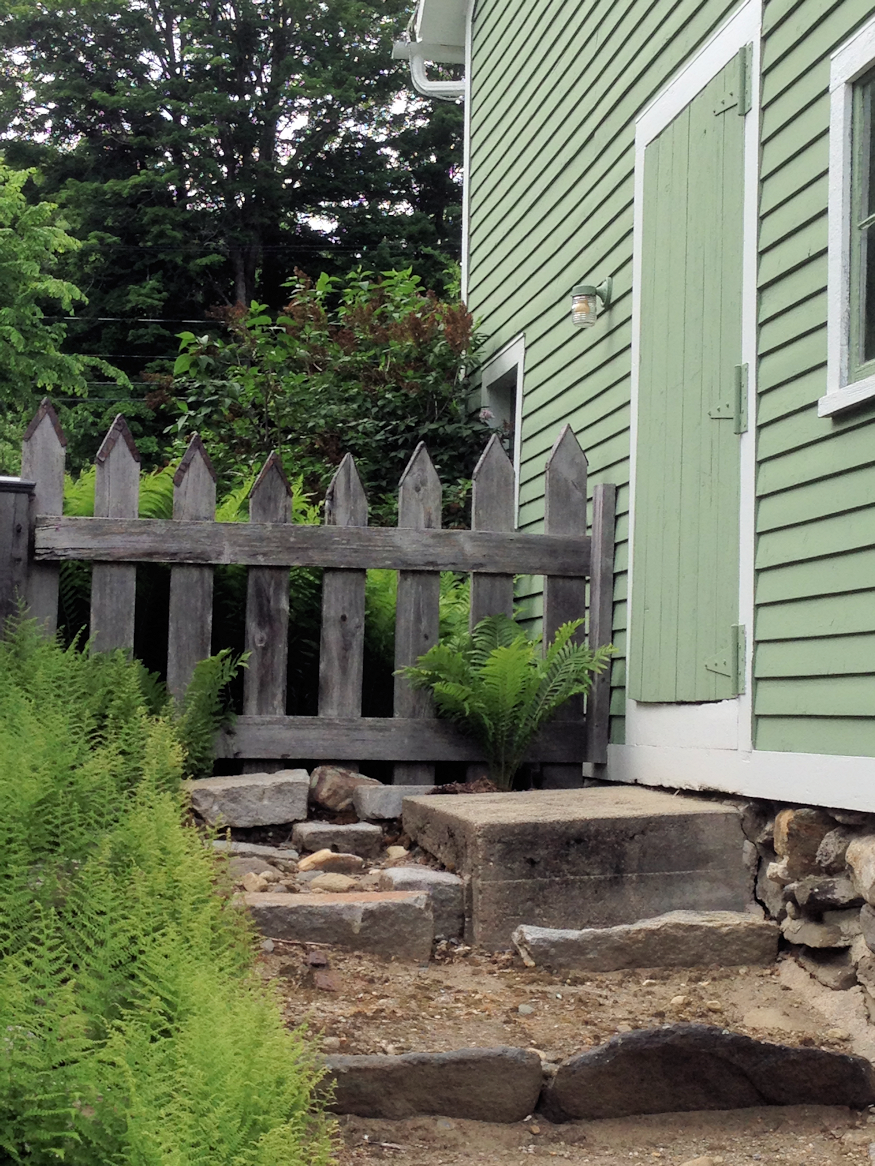
 The stall door to the barn leading to the
The stall door to the barn leading to the
stable area. Whenever Woodward could, he had
natural stone to make steps, yet this concrete
step proved to be safer for the horses
------------------------------------------------------------------------------------------------------------------------------------------------------------
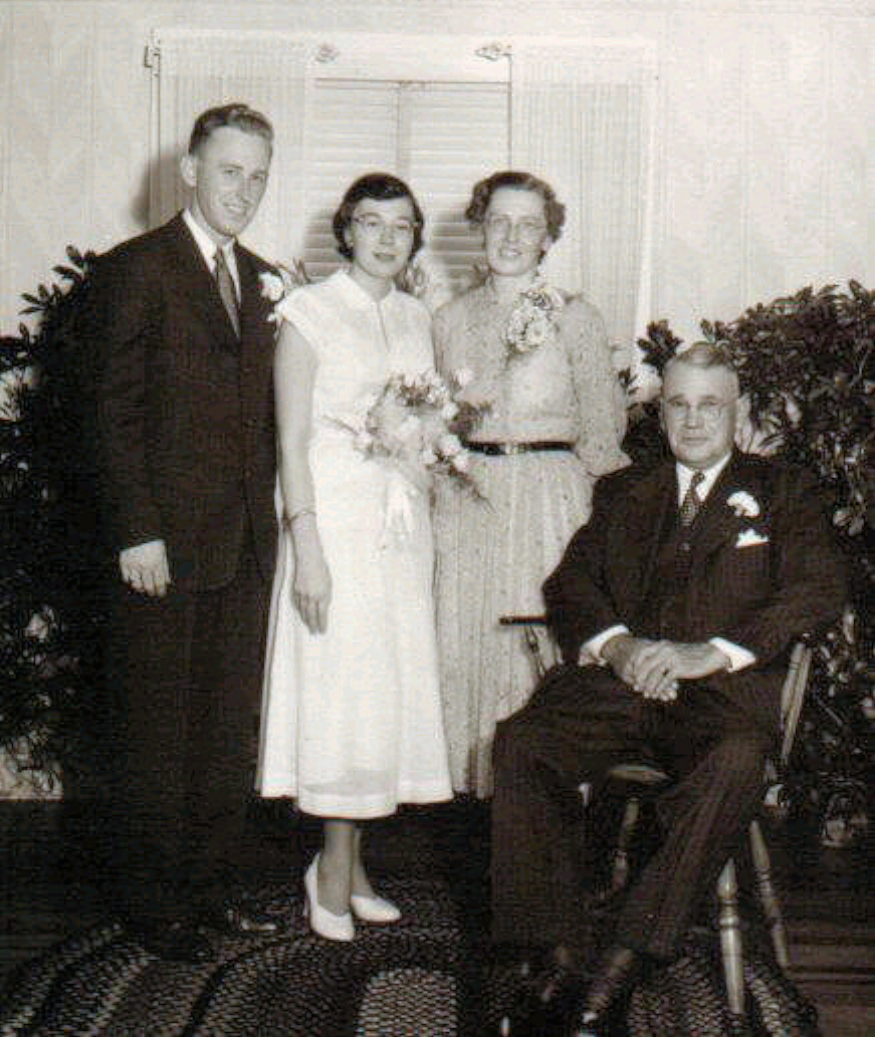
 Woodward with Mark and Barbara
Woodward with Mark and Barbara
on their wedding day August 28, 1950
Woodward would live in and work in the Southwick Place for the remander of his life - 22 years in all. Per the
small town tradition, a property is usually refered to by the name of the owner who lived in it the longest. Woodward had high regard for this tradition and affectionately called it Southwick
after blacksmith Henry Southwick who lived in the home for 51 years. Longer than anyone else until recently.
Upon his death in June of 1957, unbeknownst to him, Woodward
left newly minted Dr. Mark L. Purinton and his new bride Barbara the bulk of his estate. Dr. Mark worked for Woodward since he was 14 years old and the two had grown close enough for
Woodward to see him as his own son. Affectionately, the Purintons called him "Uncle Rob". They moved into the home in 1959 after Dr. Mark completed his surgical certification residency.
Dr. Mark and Barbara lived in the home and cared for the property for 61 years.
Despite this, Dr. Mark carried on Woodward's tradtion also referring to the property as the Southwick Place. And though it could officially be called the Purinton Place, we do not believe Dr. Mark would want that. Over the years of caring for the property, he maintained most of the work Woodward had done to the place. Dr. Mark saw to it the barn, studio & carriage house, and home were painted as Woodward left them. The house and certain things were updated as new technoloies evolved just as Woodward would have. The biggest changes to the property were to the carriage house. It would no longer be a garage but rather converted into a country doctor's office, complete with an x-ray machine... Unheard of in country doctoring!
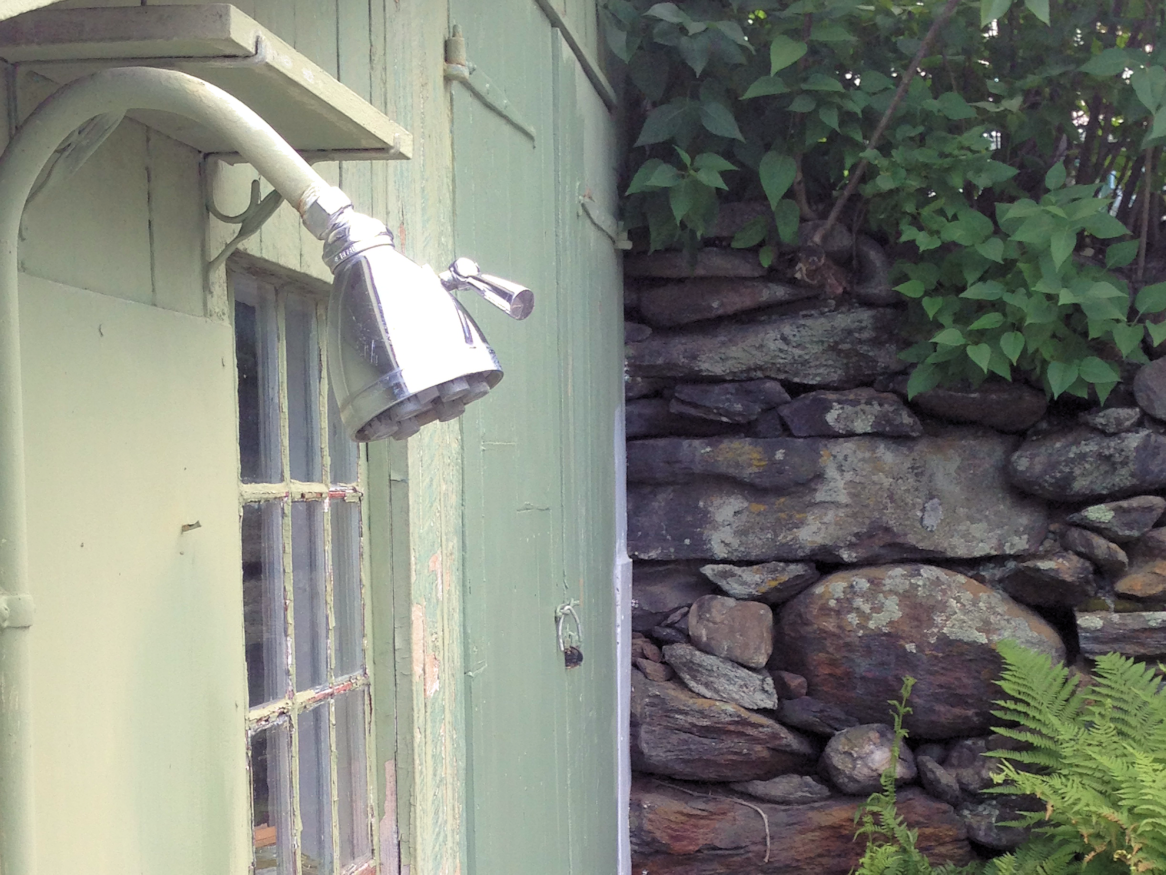
 A close up the outdoor shower added
A close up the outdoor shower added
to the old sleigh shed, now a pool house
Dr. Mark and family would also add the terrace below Woodward's lower terrace the held the inground pool,
covert the old sleigh shed into a pool house with an outdoor shower and turn a portion of the barn into a new garage to house their family car.
The main house was updated
with a new kitchen and Dr. Mark extended it by inclosing a portion of the porch on the southside of the house. The chicken coop was inclosed and converted to a china room and pantry.
One room in the house was kept pretty much as it was left by Woodward. This would be the "Dickens Room," which served as Woodward's mother Mary's private space complete with
vintage Dickens scenery wallpaper and collectables of Dickens memorabilia. Dickens was her favorite author.
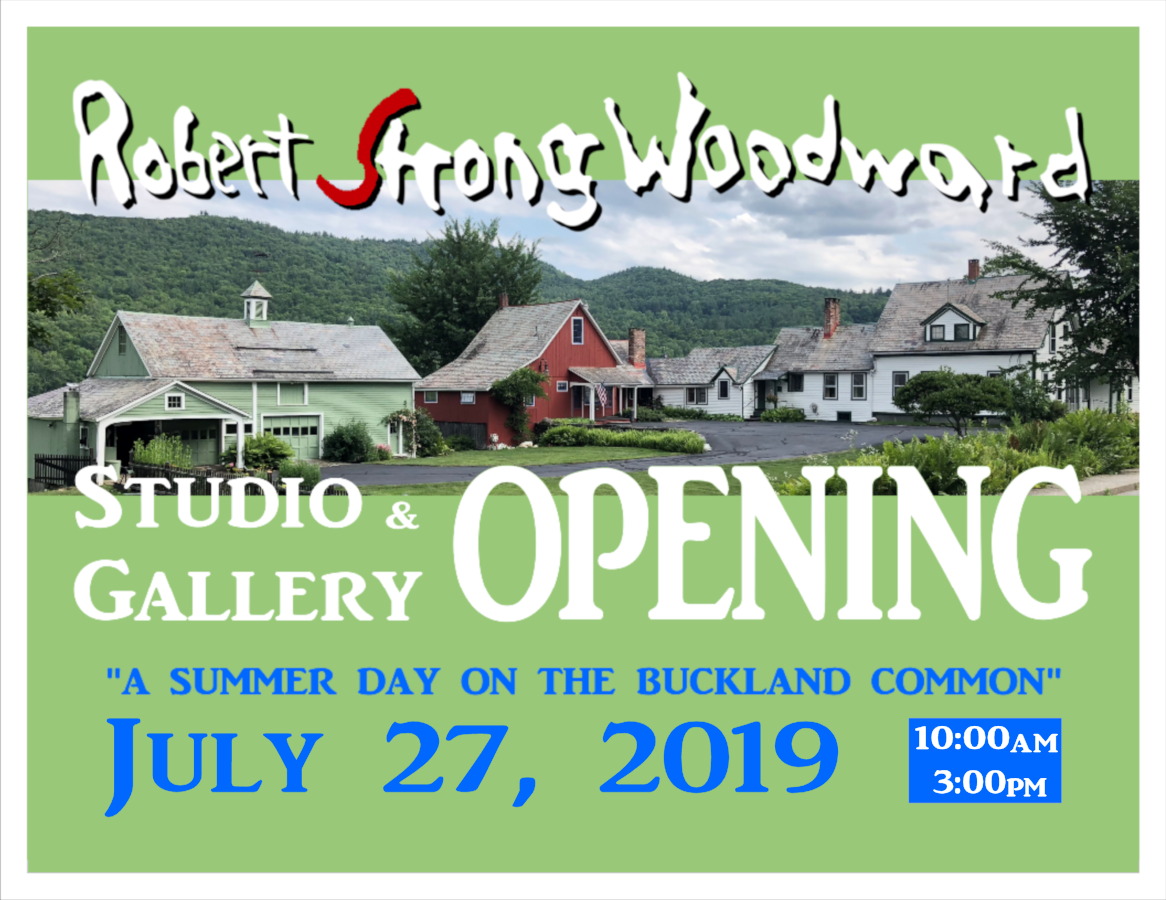
 The Flyer for the 2019 Studio opening
The Flyer for the 2019 Studio opening
The studio was left essentially as Woodward had left it. The Purinton family would use it for family events, such as Christmas celebrations, but it remained unuse otherwise. In 2017, many years after he had retired and closed up his country medical practice, Dr. Mark began converting the carraige house into a gallery in tribute to Woodward decorating it with photographs and reproductions of some his artwork. In 2018, in conjunction with the annual "A Summer Day on the Buckland Common" event held on Upper Street he opened the studio and the Carriage House Gallery to the public for the first time featuring 17 of Woodward's original paintings. And again in 2019, the studio and Carriage House Gallery was open to the public and featured a total of 24 original Woodward's and three talks on Woodward were given by this website's Brian Charle Miller.
------------------------------------------------------------------------------------------------------------------------------------------------------------
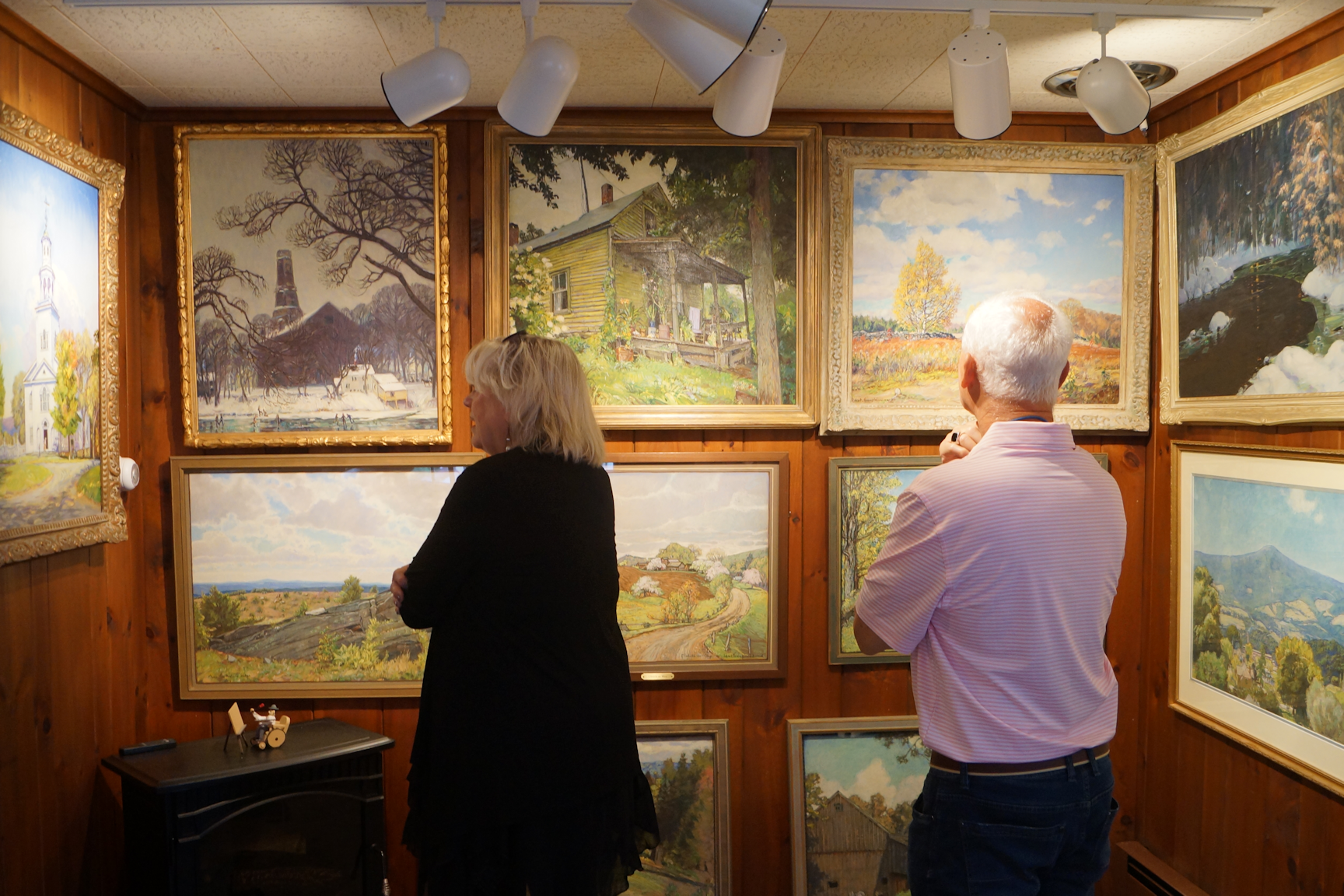
 Two guest view paintings hung
Two guest view paintings hung
for the 2019 Open House
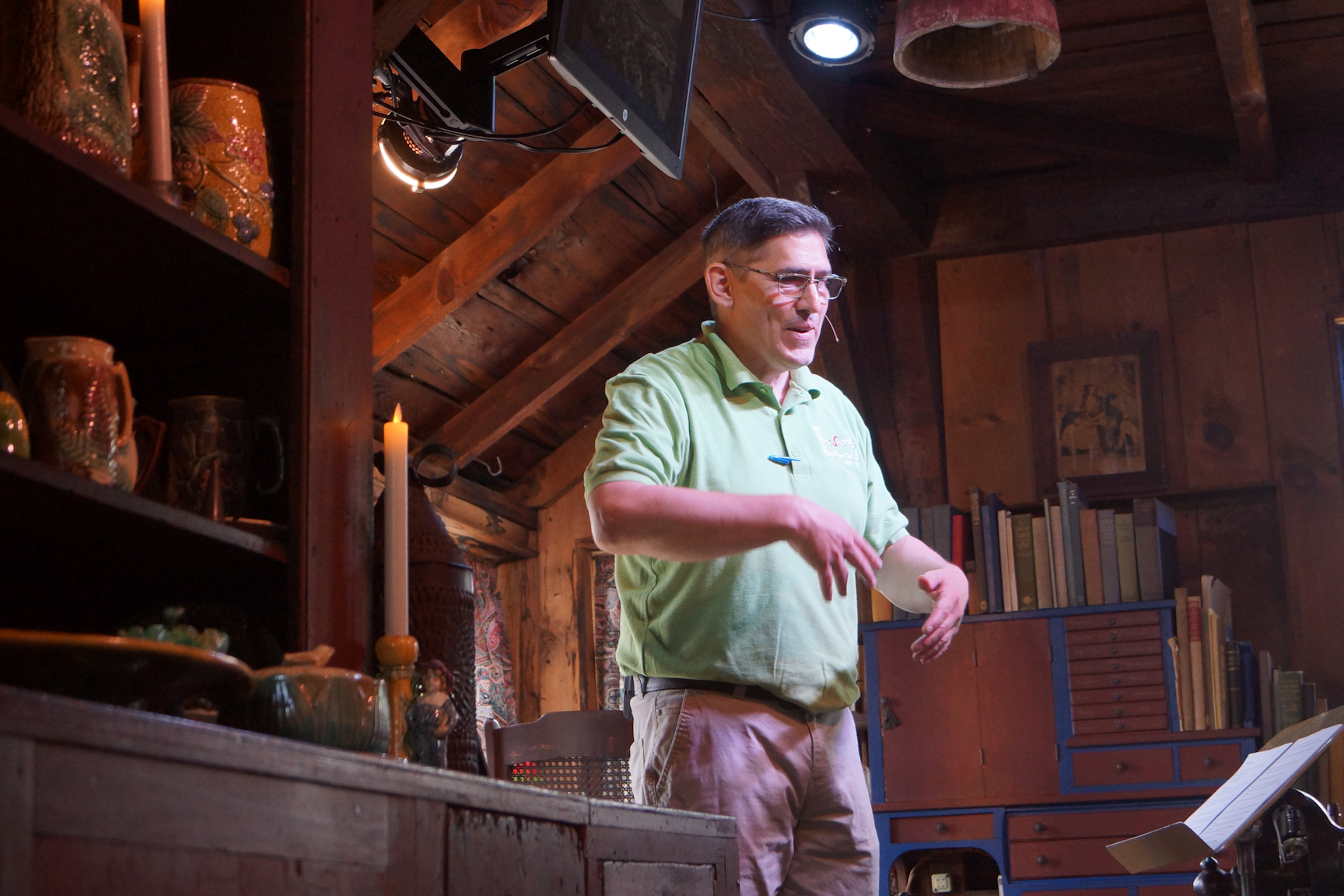
 Brian giving one of his 3 talks
Brian giving one of his 3 talks
on Woodward from the studio
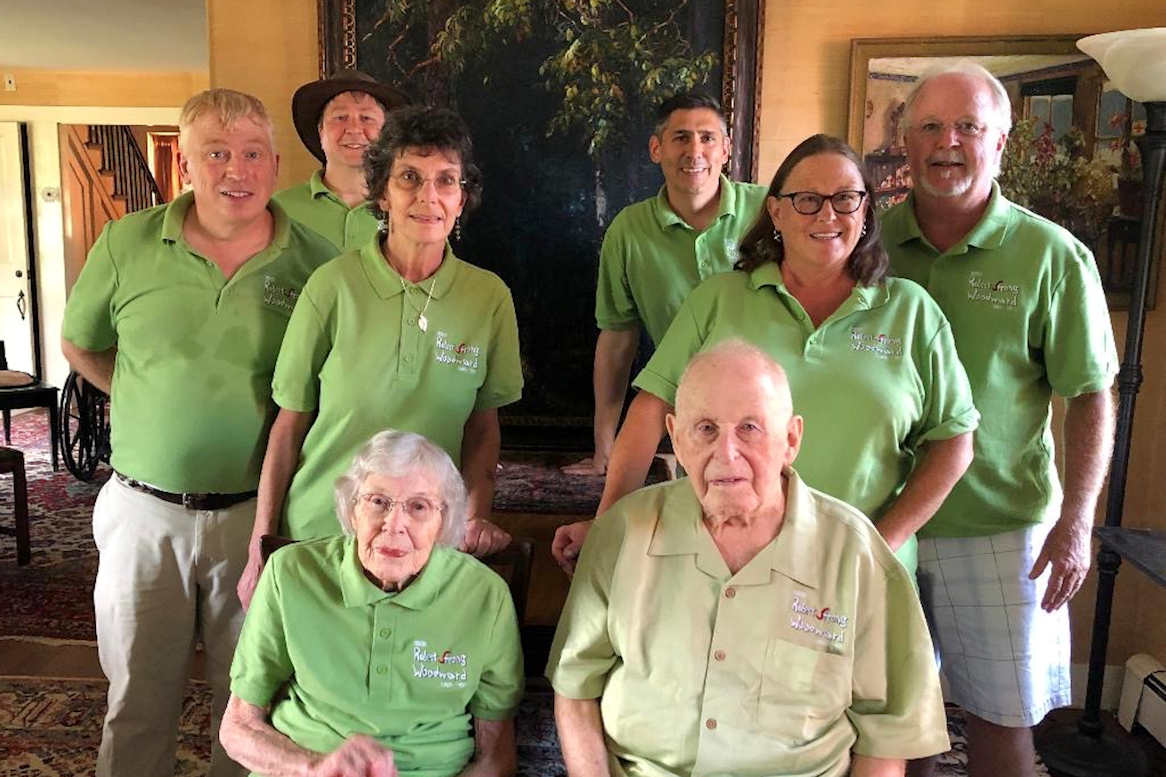
 The Woodward Family, in front is
The Woodward Family, in front is
Barbara and Mark Purinton. Behind them
from L to R: Larch Purinton, Peter Weidt,
Janet Gerry, Brian Miller, Laurel
Purinton Kerns, and Walter Kerns
------------------------------------------------------------------------------------------------------------------------------------------------------------
Unfortunately, the Covid-19 pandemic cancelled any hope for a third event. Dr. Mark had also passed quietly in his sleep on March 4th of 2020 at the age of 93. A great loss to the community of Buckland. Yet still, thanks to him the Southwick Place and Woodward's legacy rest in the beauty of his timeless design of the quintessential New England Homestead. Please continue on to Part 2 of Southwick Then & Now which exclusively focuses on the studio...
